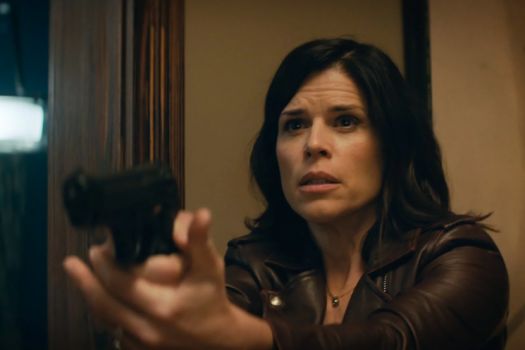For photographer and activist Nan Goldin, photographs function as witnesses to the past, serving reliably where the mind tends to confabulate or simply forget. But photographs can also be edited and arranged together in certain ways to tell a particular story, or destroyed altogether.
Goldin, in Laura Poitras's documentary All the Beauty and the Bloodshed, acknowledges this. The film, which tells the story of Goldin's life and present-day activism against the pharma giants the Sackler family, is a masterpiece for its keen observation of the crucial beats of Goldin's life, managing to remain a distinct work even as, and perhaps because, it allows Goldin's perspective and to bloom before us. Poitras is able to accomplish that tricky feat by conveying the lifeblood of the film's subject, submerging the viewers in Goldin's world.
All the Beauty and the Bloodshed begins with members of Goldin's advocacy organization, P.A.I.N. (Prescription Addiction Intervention Now), handing out mock prescription pill bottles to fellow activists before heading into the Metropolitan Museum of Art in New York City for a demonstration. We learn, through Goldin's voiceover, which is less a confessional or narration for us than it is a conversation she and Poitras are having, that P.A.I.N. is working toward harm reduction in response to the opioid crisis and the role of the Sackler family in it. (The Sacklers have paid billions in lawsuits due to downplaying the addictiveness of OxyContin.)
The film follows Goldin and P.A.I.N in their present-day work of lobbying museums to remove the Sackler name from their buildings (many of which display Goldin's work). We're also taken into Goldin's past by virtue of her autobiographical photography. Her pictures have a soft and intimate-as-lace feel to them, as they look into her life, as well as the lives of her friends, and explore her community on the fringes of society.
We see images of people like Goldin's friend and artist Cookie Mueller, along with her lovers and collaborators like David Wojnarowicz. We see Goldin's circle reckon with the AIDS epidemic in 1980s New York City (which her photography documents and humanizes), and her work to not only spread awareness of the crimes of the Sackler family but also to advocate for the safe use of drugs by those afflicted with addiction.
Punctuating Goldin's activism is the story of her sister, who died by suicide when Goldin was very young, having been labelled mentally ill for being rebellious, queer and seeking love. Throughout the whole of Goldin's story, we see a patriarchal, capitalistic system work to silence the most marginalized folks.
Poitras's style here is subtle, one that allows events and ideas to either unfold or materialize at their own pace and without heavy-handed explanation. Goldin's narration is one of the film's most compelling and affecting aspects of the film. She seems to speak in pictures, her words are almost Didion-esque and sparse. She never lapses into conjecture, allowing for the weight of the facts, as she remembers them, to settle over Poitras and us. We hear Poitras's voice sometimes, prodding Goldin in a way that isn't at all intrusive, but rather with the curiosity that a photograph might inspire. In this way, the film remains a work of art unto itself, distinct from Goldin's work, never aspiring to a mimicry of her style that some other documentaries fall into.
When Goldin and her P.A.I.N. team perform "die-ins" — falling to the ground of museums after chanting about the Sackler family's murderous culpability and the museum's complicity — Poitras's lens hovers close above Goldin's supine body with an airy gentleness that allows us as viewers to feel that we're a part of Goldin's advocacy work. That now we too carry the weight of tragedy and sadness that Goldin has accumulated over the course of her life.
Watching All the Beauty and the Bloodshed is intensely empowering for the ways in which it allows us to feel a part of something good. It's empowering for the ways in which it authentically and organically shares the stories of Goldin and her friends and fellow activists. A masterclass in showing as opposed to telling, Poitras's documentary is stunning and subtle, quietly fierce as it is incendiary, reminding us that, even as Goldin does powerful activism work, there is still more that needs doing to remove evil from this world. Ultimately, All the Beauty and the Bloodshed is powerful for containing the inimitable force that is Nan Goldin, bearing witness to her as she bears witness to her own life, to all its beauty and all its pain.
(Elevation Pictures)Goldin, in Laura Poitras's documentary All the Beauty and the Bloodshed, acknowledges this. The film, which tells the story of Goldin's life and present-day activism against the pharma giants the Sackler family, is a masterpiece for its keen observation of the crucial beats of Goldin's life, managing to remain a distinct work even as, and perhaps because, it allows Goldin's perspective and to bloom before us. Poitras is able to accomplish that tricky feat by conveying the lifeblood of the film's subject, submerging the viewers in Goldin's world.
All the Beauty and the Bloodshed begins with members of Goldin's advocacy organization, P.A.I.N. (Prescription Addiction Intervention Now), handing out mock prescription pill bottles to fellow activists before heading into the Metropolitan Museum of Art in New York City for a demonstration. We learn, through Goldin's voiceover, which is less a confessional or narration for us than it is a conversation she and Poitras are having, that P.A.I.N. is working toward harm reduction in response to the opioid crisis and the role of the Sackler family in it. (The Sacklers have paid billions in lawsuits due to downplaying the addictiveness of OxyContin.)
The film follows Goldin and P.A.I.N in their present-day work of lobbying museums to remove the Sackler name from their buildings (many of which display Goldin's work). We're also taken into Goldin's past by virtue of her autobiographical photography. Her pictures have a soft and intimate-as-lace feel to them, as they look into her life, as well as the lives of her friends, and explore her community on the fringes of society.
We see images of people like Goldin's friend and artist Cookie Mueller, along with her lovers and collaborators like David Wojnarowicz. We see Goldin's circle reckon with the AIDS epidemic in 1980s New York City (which her photography documents and humanizes), and her work to not only spread awareness of the crimes of the Sackler family but also to advocate for the safe use of drugs by those afflicted with addiction.
Punctuating Goldin's activism is the story of her sister, who died by suicide when Goldin was very young, having been labelled mentally ill for being rebellious, queer and seeking love. Throughout the whole of Goldin's story, we see a patriarchal, capitalistic system work to silence the most marginalized folks.
Poitras's style here is subtle, one that allows events and ideas to either unfold or materialize at their own pace and without heavy-handed explanation. Goldin's narration is one of the film's most compelling and affecting aspects of the film. She seems to speak in pictures, her words are almost Didion-esque and sparse. She never lapses into conjecture, allowing for the weight of the facts, as she remembers them, to settle over Poitras and us. We hear Poitras's voice sometimes, prodding Goldin in a way that isn't at all intrusive, but rather with the curiosity that a photograph might inspire. In this way, the film remains a work of art unto itself, distinct from Goldin's work, never aspiring to a mimicry of her style that some other documentaries fall into.
When Goldin and her P.A.I.N. team perform "die-ins" — falling to the ground of museums after chanting about the Sackler family's murderous culpability and the museum's complicity — Poitras's lens hovers close above Goldin's supine body with an airy gentleness that allows us as viewers to feel that we're a part of Goldin's advocacy work. That now we too carry the weight of tragedy and sadness that Goldin has accumulated over the course of her life.
Watching All the Beauty and the Bloodshed is intensely empowering for the ways in which it allows us to feel a part of something good. It's empowering for the ways in which it authentically and organically shares the stories of Goldin and her friends and fellow activists. A masterclass in showing as opposed to telling, Poitras's documentary is stunning and subtle, quietly fierce as it is incendiary, reminding us that, even as Goldin does powerful activism work, there is still more that needs doing to remove evil from this world. Ultimately, All the Beauty and the Bloodshed is powerful for containing the inimitable force that is Nan Goldin, bearing witness to her as she bears witness to her own life, to all its beauty and all its pain.




